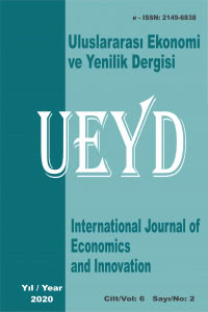İnovasyon Etkenlerinin Araştırılması ve Optimal İnovasyon Portföy Yapılanması*
Investigation of Innovation Factors and Optimal Innovation Portfolio Structuring
___
- Bashier, A. A. ve Siam, A. J. (2014). Immigration and Economic Growth In Jordan: FMOLS Approach. International Journal of Humanities Social Sciences and Education (IJHSSE), 1(9), 85-92.
- Baykal, B. (2007). İnovasyon ve Sürdürülebilir Kalkınma İlişkisi: Türkiye. Marmara Üniversitesi Sosyal Bilimler Enstitüsü Yayımlanmamış Yüksek Lisans Tezi, İstanbul.
- Beck, T., Chen, T., Lin, C., ve Song, F. M. (2016). Financial Innovation: The Bright and The Dark Sides. Journal of Banking & Finance, 72, 28-51.
- Ben-Horim, M. ve Silber, W. L. (1977). Financial Innovation: A Linear Programming Approach. Journal of Banking & Finance, 1(3), 277-296.
- Benoit, K. (2011). Linear Regression Models with Logarithmic Transformations. London School of Economics, London, 22(1), 23-36.
- Bland, J. M. ve Altman, D. G. (1995). Multiple Significance Tests: The Bonferroni Method. Bmj, 310(6973), 170.
- Dickey, D. A. ve Fuller, W. A. (1979). Distribution of The Estimators for Autoregressive Time Series with A Unit Root. Journal of the American Statistical Association, 74(366a), 427-431.
- Enders, W. (2015). Applied Econometric Time Series (Fourth Edition), Wiley.
- Eurostat Database. (2019). https://ec.europa.eu/eurostat/data/database. (Erişim: 14.03.2019).
- Furman, J. L., Porter, M. E. ve Stern, S. (2002). The Determinants of National Innovative Capacity. Research Policy, 31(6), 899-933.
- Göker, A. (2000). Prodüktivite, Inovasyon Yeteneği ve Teknoloji. MPM,“Rekabet Gücü, Teknoloji ve Verimlilik”, Tartışmalı Toplantı, MPM, Ankara, 25.
- Gujarati, D. N. (2011). Econometrics by Example, Mc-Graw Hill. (No. 330.015195 G84.).
- Gujarati, D. N. (1999). Temel Ekonometri (Basic Econometrics), İstanbul: Literatür Yayıncılık.
- Han, J. K., Kim, N. ve Srivastava, R. K. (1998). Market Orientation and Organizational Performance: Is Innovation A Missing Link?. Journal of Marketing, 62(4), 30-45.
- Hansen, B. E. ve Phillips, P. C. (1990). Estimation and Inference in Models of Cointegration: A Simulation Study. Advances in Econometrics, 8(1989), 225- 248.
- Kalay, F. ve Kızıldere, C. (2015). Türk İşletmelerinin İnovasyon Performansını Etkileyen Faktörler Üzerine Bir Araştırma. ODÜ Sosyal Bilimler Araştırmaları Dergisi (ODÜSOBİAD), 5(13), 36-63.
- Kalça, A. ve Atasoy, A. G. Y. (2008). Ekonomik Büyüme Aracı Olarak Bilgi Yayılımları ve İnovasyon. Bilgi Ekonomisi ve Yönetimi Dergisi, 3(2), 95-110.
- Kuczmarski, T. D. (1996). What Is Innovation? The Art of Welcoming Risk. Journal of Consumer Marketing, 13(5), 7-11.
- Lenger, A. ve Taymaz, E. (2006). To Innovate or To Transfer?. Journal of Evolutionary Economics, 16(1-2), 137-153.
- Litra, A. (2009). The Inflation Rate Determined as A Change in The GDP
- Deflator and in CPI. Bulletin of the Transilvania University of Brasov. Economic Sciences. Series V, 2, 207.
- Malik, S. (2020). Macroeconomic Determinants of Innovation: Evidence from Asian Countries. Global Business Review, 0972150919885494.
- Mercan, B. Göktaş, D. ve Gömleksiz, M. (2011). Ar-Ge Faaliyetleri ve Girişimcilerin İnovasyon Üzerindeki Etkileri: Patent Verileri Üzerinde Bir Uygulama. Paradoks: The Journal of Economics, Sociology & Politics, 7(2). Merkez Bankası. (2019). https://evds2.tcmb.gov.tr (Erişim: 15.01.2019).
- Merville, L. J. ve Tavis, L. A. (1973). A Generalized Model for Capital Investment. The Journal of Finance, 28(1), 109-118.
- Mosheiov, G. ve Raveh, A. (1997). On Trend Estimation of Time-Series: A Simple Linear Programming Approach. Journal of The Operational Research Society, 48(1), 90-96.
- Narayan, P. K. ve Narayan, S. (2005). Estimating Income and Price Elasticities of Imports for Fiji in A Cointegration Framework. Economic Modelling, 22(3), 423-438.
- Pedroni, P. (1996). Fully Modified OLS for Heterogeneous Cointegrated Panels and The Case of Purchasing Power Parity. Manuscript, Department of Economics, Indiana University, 1-45.
- Pesaran, M. H., Shin, Y. ve Smith, R. J. (2001). Bounds Testing Approaches to The Analysis of Level Relationships. Journal of Applied Econometrics, 16(3), 289-326.
- Phillips, P. C. ve Perron, P. (1988). Testing for A Unit Root in Time Series Regression. Biometrika, 75(2), 335-346.
- Porter, M. E. ve Stern, S. (2000). Measuring The "Ideas" Production Function: Evidence from International Patent Output (No. w7891). National Bureau of Economic Research.
- Sheth, J. (1986). Global Markets or Global Competition. Journal of Consumer Marketing, 3(2), 9-11.
- Shumway, C. R. ve Chang, A. A. (1977). Linear Programming Versus Positively Estimated Supply Functions: An Empirical and Methodological Critique. American Journal of Agricultural Economics, 59(2), 344-357.
- Sledzik, K. (2013). Schumpeter's View On Innovation and Entrepreneurship. Management Trends in Theory and Practice. University of Zilina & Institute of Management.
- Sungur, O., Aydın, H. ve Eren, M. (2016). Türkiye’de Ar-Ge, İnovasyon, İhracat ve Ekonomik Büyüme Arasındaki İlişki: Asimetrik Nedensellik Analizi. Süleyman Demirel Üniversitesi İktisadi ve İdari Bilimler Fakültesi Dergisi, 21(1), 173-192.
- Tarı, R. ve Yıldırım, D. Ç. (2009). Döviz Kuru Belirsizliğinin İhracata Etkisi: Türkiye İçin Bir Uygulama. Yönetim Ve Ekonomi: Celal Bayar Üniversitesi Iktisadi ve İdari Bilimler Fakültesi Dergisi, 16(2), 95-105.
- TPE. (2019). https://www.turkpatent.gov.tr/TURKPATENT/statistics (Erişim: 14.03.2019).
- TÜİK. (2018). http://www.tuik.gov.tr/UstMenu.do?metod=kategorist (Erişim: 20.12.2018).
- Tüylüoğlu, Ş. ve Saraç, Ş. (2012). Gelişmiş ve Gelişmekte Olan Ülkelerde İnovasyonun Belirleyicileri: Ampirik Bir Analiz. Eskişehir Osmangazi Üniversitesi İktisadi ve İdari Bilimler Dergisi, 7(1), 39-74.
- Varsakelis, N. C. (2001). The Impact of Patent Protection, Economy Openness and National Culture On R&D Investment: A Cross-Country Empirical Investigation. Research Policy, 30(7), 1059-1068.
- Weerawardena, J. ve Mavondo, F. T. (2011). Capabilities, Innovation and Competitive Advantage. Industrial Marketing Management, 40(8), 1220-1223.
- Worldbank. (2020). https://data.worldbank.org (Erişim: 30.01.2020).
- ISSN: 2149-6838
- Yayın Aralığı: 2
- Başlangıç: 2015
- Yayıncı: Seyfettin Artan
Türkiye’de Yenilenebilir Enerji Tüketimi, Tarım ve CO2 Emisyonu İlişkisi
İnovasyon Etkenlerinin Araştırılması ve Optimal İnovasyon Portföy Yapılanması
İşgörenlerin Örgütsel Politika Algısına Tepkilerinin Belirlenmesinde İş Tatminin Rolü
The Relationship between Women’s Employment and Divorce: An Empirical Analysis on Turkey
Göç, İşsizlik ve Gelir Arasındaki İlişkilerin Analizi: OECD Ülkeleri Örneği
Türkiye’de Doğrudan Yabancı Yatırımlar, Karbon Emisyonu ve İktisadi Büyüme: Veriye Dayalı Bir Analiz
Financial Performance Evaluation of Food and Drink Index Using Fuzzy MCDM Approach*
Göç, İşsizlik ve Gelir Arasındaki İlişkilerin Analizi: OECD Ülkeleri Örneği*
Financial Performance Evaluation of Food and Drink Index Using Fuzzy MCDM Approach
Kadınların İstihdamı ve Boşanma İlişkisi: Türkiye Üzerine Ampirik Bir Analiz
